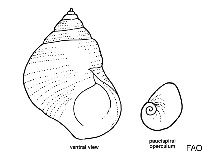Littorina keenae Rosewater, 1978
Eroded periwinkle| Native range | All suitable habitat | Point map | Year 2050 |

|
| This map was computer-generated and has not yet been reviewed. |
| Littorina keenae AquaMaps Data sources: GBIF OBIS |
Upload your photos
Google image | No image available for this species;
drawing shows typical species in Littorinidae.
Google image | No image available for this species;
drawing shows typical species in Littorinidae.
Classification / Names Common names | Synonyms | CoL | ITIS | WoRMS
| Littorinimorpha | Littorinidae
Environment: milieu / climate zone / depth range / distribution range বাস্তুসংস্থান
. Subtropical
বিতরণ দেশ সমূহ | এফ এ ও এলাকাসমূহ | বাস্তুতন্ত্র | দৃষ্টিগোচর | প্রচলন
Eastern Pacific: USA to Mexico.
Length at first maturity / আকৃতি / ওজন / Age
Maturity: Lm ? range ? - ? cmCommon length : 2.0 cm SHL পুরুষ/ লিঙ্গ অনিধর্ারিত ; (Ref. 312)
Short description বহিঃ অঙ্গ সংস্থান
Shell has 2 whorls, and is usually eroded at tip. Purplish brown with faint white markings and a white band on the edge of the shell's mouth; smooth, flat surface next to opening. It is an important source of erosion of high intertidal cliffs (Ref. 312).
It has a shell length of 2 cm long (Ref. 312). Found in the splash and high intertidal zones. Scrapes films of diatoms, blue-green algae and green algae off rocks. When not feeding or crawling, it prevents water loss by secreting a mucous film to attach its foot to surfaces. The mucous seal and operculum (trap door), which snugly fits into the shell, are so effective that they remain alive for two or three months without being submerged under water. They need only to get their gills wet from the water's spray (Ref. 312).
Life cycle and mating behavior পরিপক্কতা | প্রজনন | ডিম ছাড়া | ডিমসমূহ | ডিম্বধারন ক্ষমতা | শুককীট
Members of the order Neotaenioglossa are mostly gonochoric and broadcast spawners. Life cycle: Embryos develop into planktonic trocophore larvae and later into juvenile veligers before becoming fully grown adults.
Main reference
সূত্র সংখ্যা | সমম্বয়কারী | সহযোগী
Gallivan, G. and J. Danforth. 1999. (Ref. 312)
IUCN Red List Status (Ref. 130435)
CITES status (Ref. 108899)
Not Evaluated
CMS (Ref. 116361)
Not Evaluated
Threat to humans
Human uses
| FishSource |
হাতিয়ার
আরো তথ্য
প্রচলিত নাম সমূহ
প্রতিনাম সমূহ
শিকারী প্রাণী সমূহ
প্রজনন
পরিপক্কতা
ডিম ছাড়া
ডিম্বধারন ক্ষমতা
ডিমসমূহ
Egg development
প্রতিনাম সমূহ
শিকারী প্রাণী সমূহ
প্রজনন
পরিপক্কতা
ডিম ছাড়া
ডিম্বধারন ক্ষমতা
ডিমসমূহ
Egg development
ইন্টারনেট সুত্র
BHL | BOLD Systems | CISTI | DiscoverLife | FAO(Publication : search) | Fishipedia | GenBank (genome, nucleotide) | GloBI | Gomexsi | Google Books | Google Scholar | Google | PubMed | জীবন বৃক্ষ | Wikipedia (Go, অনুসন্ধান ) | জুলজিকাল রেকর্ড
Estimates based on models
Preferred temperature
(Ref. 115969): 9.3 - 24.6, mean 11.2 (based on 223 cells).



